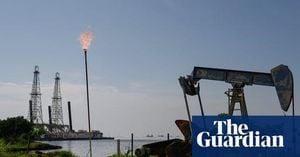In a dramatic escalation of the ongoing conflict between Ukraine and Russia, Ukrainian forces launched coordinated drone and missile strikes on two major Russian oil refineries—Saratov in Saratov Oblast and Orsk in Orenburg Oblast—during the night of November 11, 2025. These attacks, confirmed by both Ukrainian and Russian sources, targeted key components of Russia’s fuel infrastructure, sending plumes of fire and smoke into the night sky and raising fresh questions about the war’s trajectory and the vulnerability of critical assets far from the front lines.
The Saratov oil refinery, a sprawling facility known for producing more than 20 types of petroleum products—including gasoline, fuel oil, diesel fuel, vacuum gas oil, and technical sulfur—was struck first. The refinery is widely recognized as a crucial supplier for Russian military operations, a fact underscored by Ukraine’s General Staff, which stated the attack aimed to "degrade the military-economic potential of the Russian aggressor." According to Ukrinform, the Ukrainian Defense Forces claimed responsibility for the strike, emphasizing its strategic intent: "The facility produces more than 20 types of petroleum products... It is used to meet the needs of the Russian invading army."
Witnesses in Saratov city described a harrowing scene as explosions rocked the southwestern part of the city shortly after midnight, followed by the wail of sirens and the sight of flames leaping above the skyline. The governor of Saratov Oblast, Roman Busargin, acknowledged damage to civilian infrastructure, though he stopped short of specifying which facilities were affected. The Russian Defense Ministry later reported that 37 Ukrainian drones had been detected over Russia that night, with eight intercepted in Saratov Oblast alone. Despite these interceptions, the attack resulted in a series of explosions and a large fire at the refinery, the full extent of which was still being assessed as daylight broke.
This was not the first time the Saratov refinery had come under attack. Just days earlier, on November 3, Ukrainian drones had targeted the same facility, signaling a persistent campaign to disrupt Russia’s military logistics and fuel supply chain. Analysts note that repeated strikes on such infrastructure can have a compounding effect, not only hampering Russia’s immediate war effort but also straining its broader economic resilience.
But Saratov was not the only target that night. Hundreds of kilometers to the east, in Russia’s Orenburg region, the Orsk oil refinery was also hit by Ukrainian forces. According to reports from the General Staff of the Armed Forces of Ukraine, as well as independent witnesses cited by Devdiscourse and Ukrainska Pravda, the attack on Orsk resulted in explosions and a significant fire on the premises. Early accounts indicated that one of the refinery’s central oil processing units was directly struck, though the full results of the operation were still being clarified at press time.
The Orsk refinery is a major industrial complex in its own right, boasting a designed refining capacity of 6.6 million tonnes of oil per year and producing over 30 types of petroleum products, including petrol, diesel fuel, aviation kerosene, and lubricating oils. Like Saratov, Orsk plays a vital role in supplying the Russian occupation forces, making it a high-value target for Ukrainian military planners. The attack on Orsk, as reported by Quantum Commodity Intelligence, occurred simultaneously with the Saratov strike, underscoring the coordinated nature of Ukraine’s latest offensive against Russian energy infrastructure.
The night’s operations did not stop at oil refineries. According to Ukrinform, Ukrainian forces also struck the Morskoy Neftyanoy Terminal JSC in occupied Feodosia, Crimea—a key hub for supplying fuel and lubricants by sea to the Crimean Peninsula and other Russian-occupied territories in southern Ukraine. Impacts on storage tanks at the terminal were confirmed, though the extent of the damage was still under assessment. Additional strikes reportedly hit a logistics warehouse and a personnel cluster near Ocheretyne in the temporarily occupied Donetsk region, with attack drones reaching their target areas. The General Staff of Ukraine also confirmed an earlier strike on an oil-processing facility in Russia’s Krasnodar Krai, suggesting a broader pattern of targeting energy assets deep within Russian-controlled territory.
These attacks come at a time when both sides are seeking to gain leverage through the disruption of critical infrastructure. For Ukraine, targeting Russian oil refineries and supply hubs serves a dual purpose: it directly impairs the enemy’s ability to sustain military operations and sends a message that no part of Russia’s war machine is beyond reach. As the General Staff of Ukraine put it, the Defense Forces "continue to take all measures to undermine the military-economic potential of the Russian invading forces and force Russia to cease its armed aggression against Ukraine."
For Russia, the strikes represent a sobering reminder of the vulnerabilities inherent in its vast and complex supply networks. The Russian Defense Ministry’s report of intercepting eight drones over Saratov Oblast may offer some reassurance to the public, but the fact that both Saratov and Orsk refineries suffered significant damage suggests that Ukraine’s drone and missile capabilities remain a potent threat. The attacks also raise questions about the adequacy of Russian air defenses and the potential for further strikes on other high-value targets.
The broader implications for global energy markets are still unfolding. Previous Ukrainian attacks, such as the November 2 strike that halted operations at the Tuapse port on Russia’s Black Sea coast, have already had ripple effects on regional oil and fuel supplies. As Quantum Commodity Intelligence notes, the latest round of strikes further complicates the outlook for Russia’s oil exports and could impact prices and availability in neighboring countries.
On the ground, the human impact is just as real. Residents of Saratov and Orsk faced a night of uncertainty and fear, with explosions shattering the calm and fires lighting up the sky. While official reports have so far focused on infrastructure damage, the psychological toll on communities living near these strategic facilities should not be underestimated.
As the conflict grinds on, one thing is clear: the war between Ukraine and Russia is no longer confined to the trenches and front lines. With each new strike on critical infrastructure, the stakes rise—not just for the combatants, but for the millions who depend on the steady flow of energy, goods, and stability that these facilities once represented. The events of November 11, 2025, mark yet another turning point in a conflict where the boundaries between military and civilian targets are increasingly blurred, and the consequences are felt far beyond the immediate blast zone.






